trailer TOYOTA CAMRY 2018 Owners Manual (in English)
[x] Cancel search | Manufacturer: TOYOTA, Model Year: 2018, Model line: CAMRY, Model: TOYOTA CAMRY 2018Pages: 612, PDF Size: 10.63 MB
Page 2 of 612

TABLE OF CONTENTS2
CAMRY_U (01999-06139)For your information....................... 6
Reading this manual .................... 10
How to search .............................. 11
Pictorial index .............................. 12
1-1. For safe use
Before driving ...................... 22
For safe driving ................... 24
Seat belts ............................ 26
SRS airbags ........................ 32
Front passenger occupant classification system ......... 45
Exhaust gas precautions ..... 50
1-2. Child safety Riding with children ............. 51
Child restraint systems ........ 52
1-3. Theft deterrent system Engine immobilizer system............................... 71
Alarm ................................... 74
2. Instrument cluster Warning lights and indicators........................... 78
Gauges and meters............. 84
Multi-information display (4.2-inch display)............... 87
Multi-information display (7-inch display).................. 99
Head-up display ................ 113
Fuel consumption information ...................... 120 3-1. Key information
Keys................................... 126
3-2. Opening, closing and locking the doors
Doors ................................. 135
Trunk ................................. 144
Smart key system .............. 149
3-3. Adjusting the seats Front seats......................... 158
Rear seats ......................... 160
Head restraints .................. 162
3-4. Adjusting the steering wheel and mirrors
Steering wheel ................... 164
Inside rear view mirror ....... 166
Outside rear view mirrors ............................. 168
3-5. Opening and closing the windows
Power windows.................. 170
Moon roof .......................... 174
Panoramic moon roof ........ 178
4-1. Before driving Driving the vehicle ............. 184
Cargo and luggage ............ 192
Vehicle load limits .............. 195
Trailer towing ..................... 196
Dinghy towing .................... 197
1For safety and security
2Instrument cluster
3Operation of each
component
4Driving
Page 183 of 612

183
4Driving
CAMRY_U (01999-06139)4-1. Before driving
Driving the vehicle ............. 184
Cargo and luggage ........... 192
Vehicle load limits ............. 195
Trailer towing..................... 196
Dinghy towing ................... 197
4-2. Driving procedures Engine (ignition) switch (vehicles without a
smart key system) ........... 198
Engine (ignition) switch (vehicles with a smart
key system) ..................... 200
Automatic transmission .................... 205
Turn signal lever................ 211
Parking brake .................... 212
Electric parking brake........ 213
Brake Hold ........................ 217
4-3. Operating the lights and wipers
Headlight switch ................ 219
Automatic High Beam ....... 223
Windshield wipers and washer ............................ 227 4-4. Refueling
Opening the fuel tank cap .................................. 231
4-5. Using the driving support systems
Toyota Safety Sense P ..... 235
PCS (Pre-Collision System)........................... 242
LDA (Lane Departure Alert with steering
control) ............................ 253
Dynamic radar cruise control with full-speed
range............................... 263
Dynamic radar cruise control ............................. 276
Cruise control .................... 289
Driving assist systems ...... 294
BSM (Blind Spot Monitor) ........ 300
• BSM function ................ 304
• RCTA function .............. 306
Rear Camera Detection Function .......................... 310
Intuitive parking assist....... 314
Intelligent Clearance Sonar (ICS) ..................... 322
Driving mode select switches .......................... 343
4-6. Driving tips Winter driving tips ............. 345
Page 192 of 612
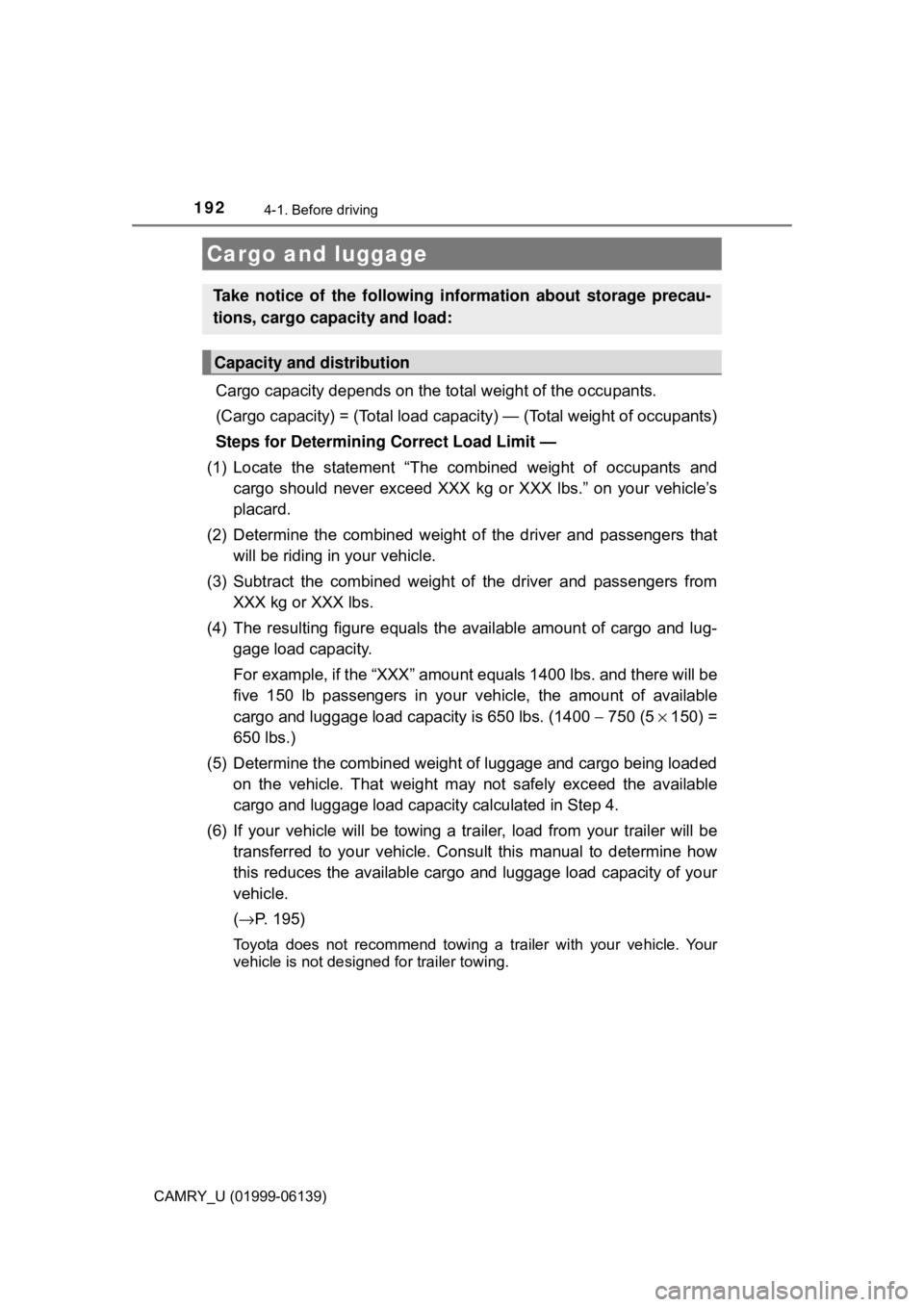
1924-1. Before driving
CAMRY_U (01999-06139)
Cargo capacity depends on the total weight of the occupants.
(Cargo capacity) = (Total load capacity) — (Total weight of occupants)
Steps for Determining Correct Load Limit —
(1) Locate the statement “The comb ined weight of occupants and
cargo should never exceed XXX kg or XXX lbs.” on your vehicle’s
placard.
(2) Determine the combined weight of the driver and passengers that
will be riding in your vehicle.
(3) Subtract the combined weight of the driver and passengers from
XXX kg or XXX lbs.
(4) The resulting figure equals the available amount of cargo and lug- gage load capacity.
For example, if the “ XXX” amount equals 1400 lbs. and there will be
five 150 lb passengers in your v ehicle, the amount of available
cargo and luggage load capacity is 650 lbs. (1400 − 750 (5 × 150) =
650 lbs.)
(5) Determine the combined weight of luggage and cargo being loaded on the vehicle. That weight ma y not safely exceed the available
cargo and luggage load capacity calculated in Step 4.
(6) If your vehicle will be towing a tr ailer, load from your trailer will be
transferred to your vehicle. Consult this manual to determine how
this reduces the available cargo and luggage load capacity of your
vehicle.
( → P. 195)
Toyota does not recommend towing a trailer with your vehicle. Your
vehicle is not designed for trailer towing.
Cargo and luggage
Take notice of the following information about storage precau-
tions, cargo capacity and load:
Capacity and distribution
Page 195 of 612
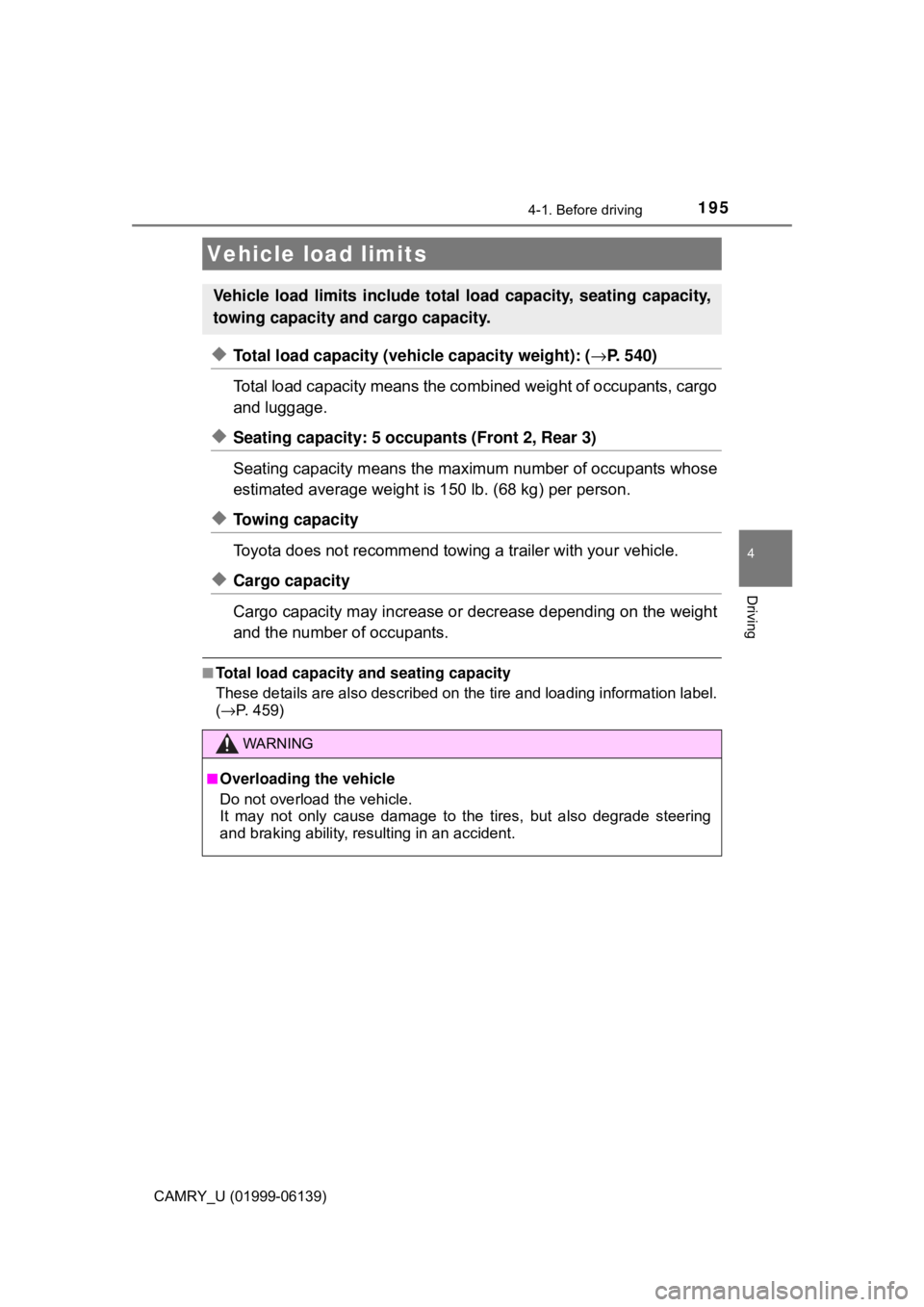
1954-1. Before driving
4
Driving
CAMRY_U (01999-06139)
◆Total load capacity (vehicle capacity weight): (→P. 540)
Total load capacity means the comb ined weight of occupants, cargo
and luggage.
◆Seating capacity: 5 occupants (Front 2, Rear 3)
Seating capacity means the maxi mum number of occupants whose
estimated average weight is 150 lb. (68 kg) per person.
◆Towing capacity
Toyota does not recommend towing a trailer with your vehicle.
◆Cargo capacity
Cargo capacity may increase or decrease depending on the weight
and the number of occupants.
■Total load capacity and seating capacity
These details are also described on the tire and loading information label.
( → P. 459)
Vehicle load limits
Vehicle load limits include total load capacity, seating capacity,
towing capacity and cargo capacity.
WARNING
■Overloading the vehicle
Do not overload the vehicle.
It may not only cause damage to the tires, but also degrade steering
and braking ability, resu lting in an accident.
Page 196 of 612
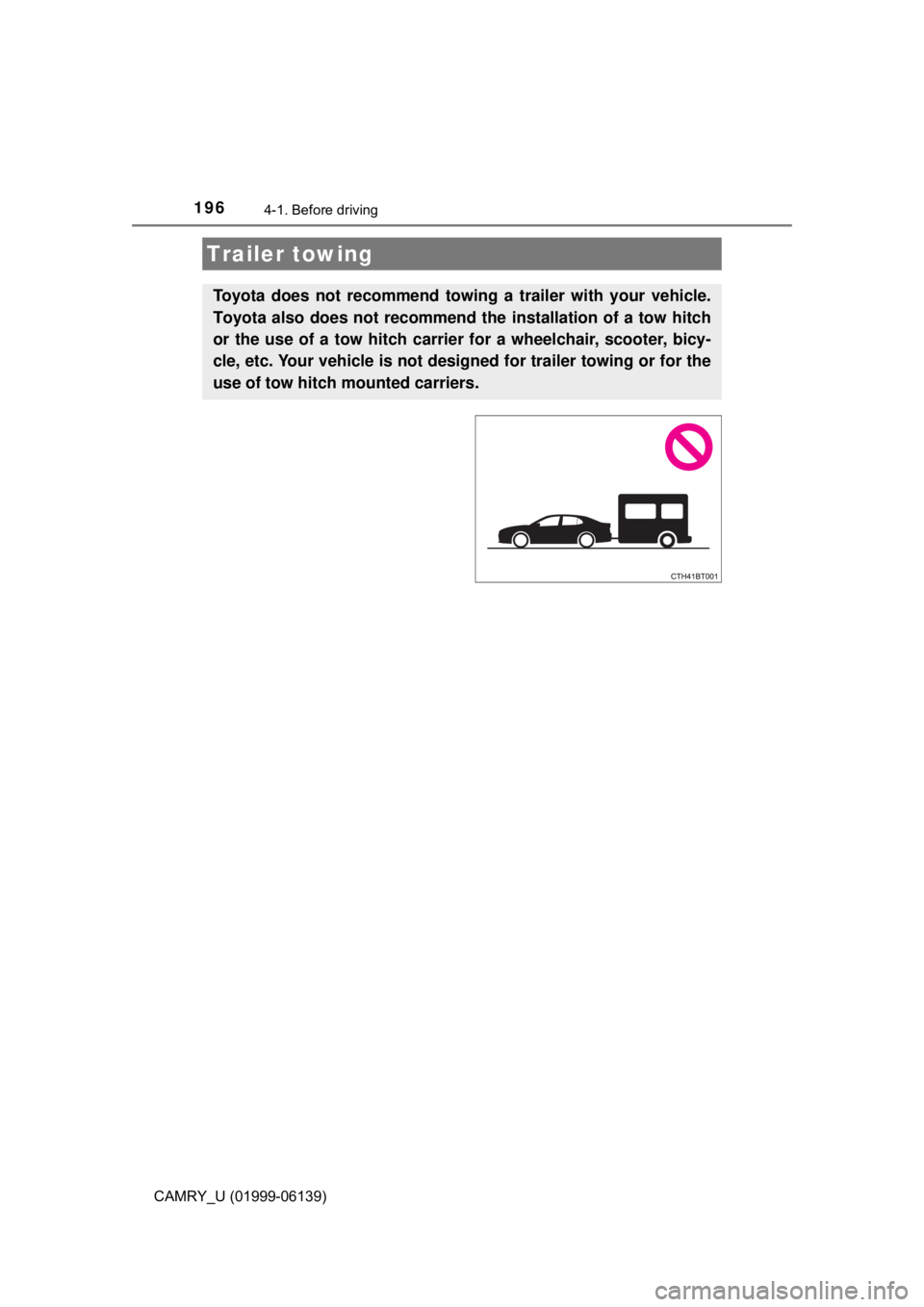
1964-1. Before driving
CAMRY_U (01999-06139)
Trailer towing
Toyota does not recommend towing a trailer with your vehicle.
Toyota also does not recommend the installation of a tow hitch
or the use of a tow hitch carrier for a wheelchair, scooter, bicy-
cle, etc. Your vehicle is not desi gned for trailer towing or for the
use of tow hitch mounted carriers.
Page 226 of 612

2264-3. Operating the lights and wipers
CAMRY_U (01999-06139)●
In the following situations the system may not be able to correctly detect the
surrounding brightness level. This may cause the low beams to remain on
or the high beams to flash or dazzle pedestrians or vehicles ahead. In such
a case, it is necessary to manually switch between the high and low beams.
• When driving in inclement weather (heavy rain, snow, fog, sandstorms,
etc.)
• When the windshield is obscured by fog, mist, ice, dirt, etc.
• When the windshield is cracked or damaged
• When the camera sensor is deformed or dirty
• When the temperature of the camera sensor is extremely high
• When the surrounding brightness level is equal to that of headlights, tai\
l lights or fog lights
• When headlights or tail lights of vehicles ahead are turned off, dirty,
changing color, or not aimed properly
• When the vehicle is hit by water, snow, dust, etc. from a preceding vehi- cle
• When driving through an area of in termittently changing brightness and
darkness
• When frequently and repeatedly driving ascending/descending roads, or
roads with rough, bumpy or uneven surfaces (such as stone-paved
roads, gravel roads, etc.)
• When frequently and repeatedly taking curves or driving on a winding
road
• When there is a highly reflective object ahead of the vehicle, such as a sign or mirror
• When the back of a preceding vehicle is highly reflective, such as a con- tainer on a truck
• When the vehicle's headlights are damaged or dirty, or are not aimed properly
• When the vehicle is listing or titling due to a flat tire, a trailer being towed,
etc.
• When the headlights are changed between the high beams and low beams repeatedly in an abnormal manner
• When the driver believes that the high beams may be flashing or dazzling pedestrians or other drivers
■ Temporarily lowering sensor sensitivity
The sensitivity of the sensor can be temporarily lowered.
Turn the engine switch off while the following conditions are met.
• The headlight switch is in .
• The headlight switch lever is in high beam position.
Turn the engine switch to the “ON” position (vehicles without a smart key
system) or IGNITION ON mode (vehicles with a smart key system).
Within 5 seconds after , repeat pulling the headlight switch lever to the
original position then pushing it to the high beam position quickly 9 times,
then leave the lever in high beam position.
Automatic High Beam (headlights) may turn on even when the vehicle is
stopped.
1
2
32
Page 249 of 612
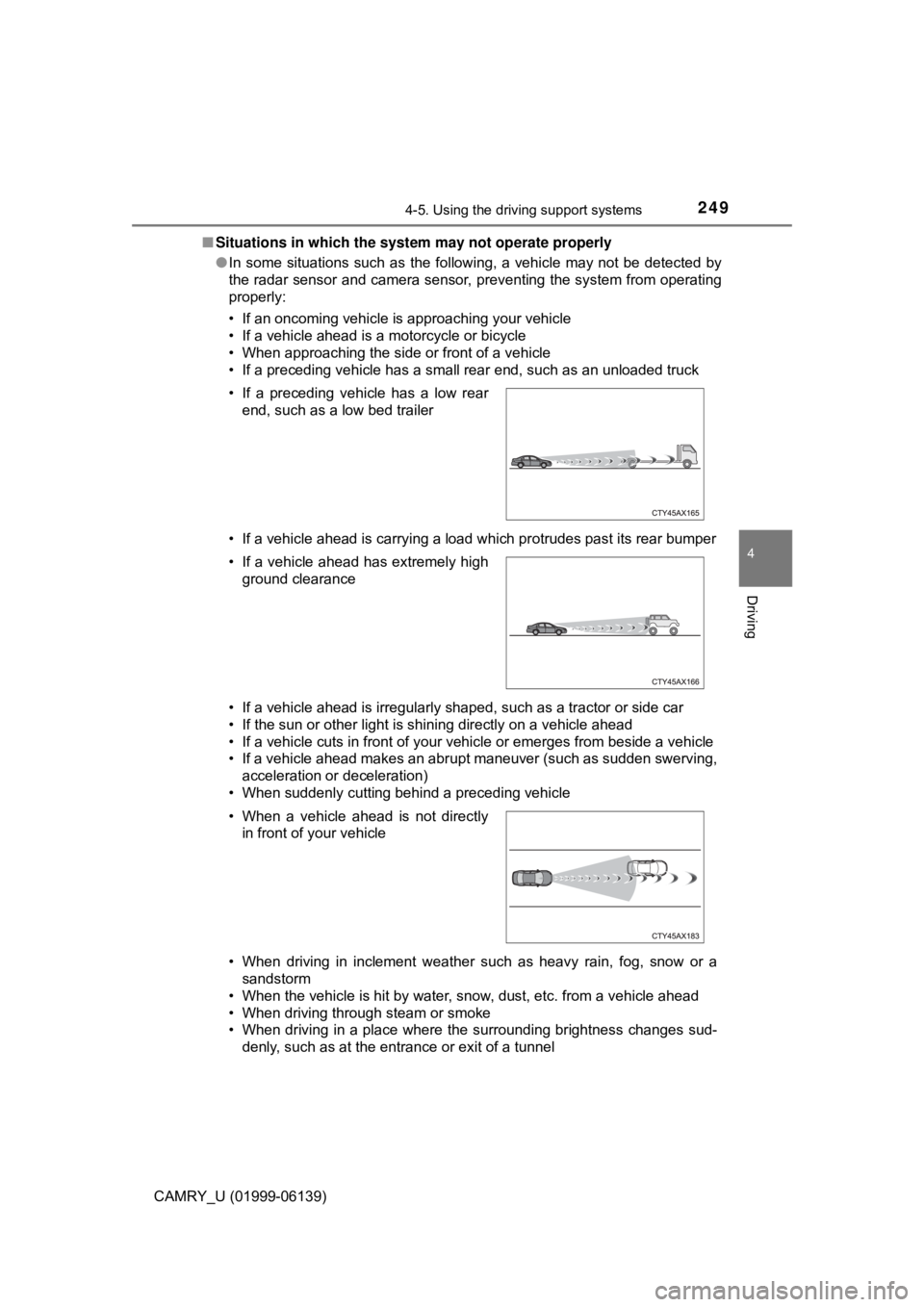
2494-5. Using the driving support systems
4
Driving
CAMRY_U (01999-06139)■
Situations in which the system may not operate properly
●In some situations such as the following, a vehicle may not be detected by
the radar sensor and camera sensor, preventing the system from operating
properly:
• If an oncoming vehicle is approaching your vehicle
• If a vehicle ahead is a motorcycle or bicycle
• When approaching the side or front of a vehicle
• If a preceding vehicle has a small rear end, such as an unloaded truck
• If a vehicle ahead is carrying a load which protrudes past its rear bumper
• If a vehicle ahead is irregularly shaped, such as a tractor or side car
• If the sun or other light is shining directly on a vehicle ahead
• If a vehicle cuts in front of your vehicle or emerges from beside a vehicle
• If a vehicle ahead makes an abrupt maneuver (such as sudden swerving,
acceleration or deceleration)
• When suddenly cutting behind a preceding vehicle
• When driving in inclement weather such as heavy rain, fog, snow or a sandstorm
• When the vehicle is hit by water, snow, dust, etc. from a vehicle ahead
• When driving through steam or smoke
• When driving in a place where the surrounding brightness changes sud- denly, such as at the entrance or exit of a tunnel
• If a preceding vehicle has a low rear
end, such as a low bed trailer
• If a vehicle ahead has extremely high ground clearance
• When a vehicle ahead is not directly in front of your vehicle
Page 274 of 612
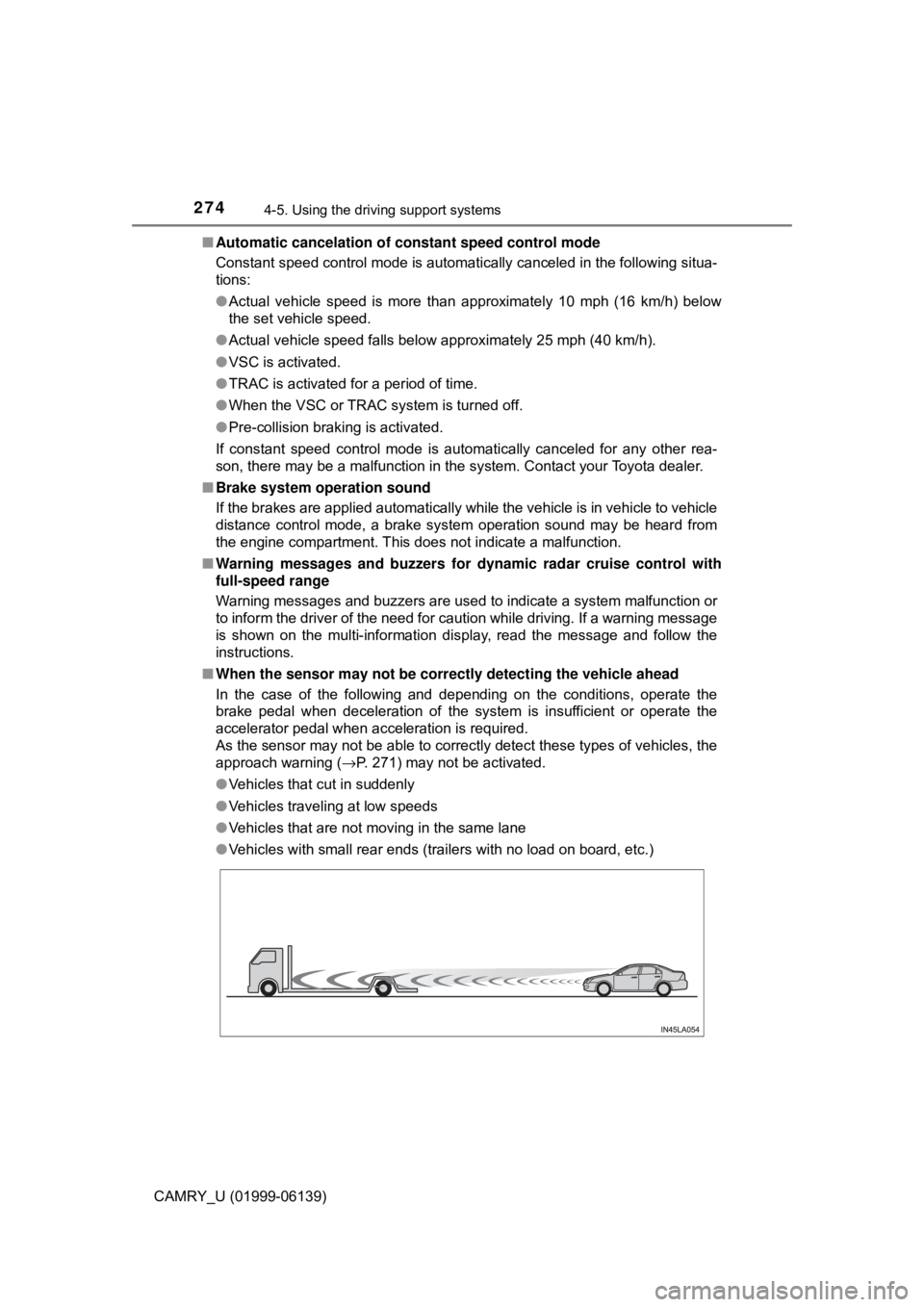
2744-5. Using the driving support systems
CAMRY_U (01999-06139)■
Automatic cancelation of co nstant speed control mode
Constant speed control mode is automatically canceled in the following situa-
tions:
● Actual vehicle speed is more than approximately 10 mph (16 km/h) below
the set vehicle speed.
● Actual vehicle speed falls below approximately 25 mph (40 km/h).
● VSC is activated.
● TRAC is activated for a period of time.
● When the VSC or TRAC system is turned off.
● Pre-collision braking is activated.
If constant speed control mode is automatically canceled for any other rea-
son, there may be a malfunction in the system. Contact your Toyota dealer.
■ Brake system oper ation sound
If the brakes are applied automatically whil e the vehicle is in vehicle to vehicle
distance control mode, a brake system operation sound may be heard from
the engine compartment. This does not indicate a malfunction.
■ Warning messages and buzzers for dy namic radar cruise control with
full-speed range
Warning messages and buzzers are used to indicate a system malfunction or
to inform the driver of the need for caution while driving. If a warning message
is shown on the multi-information display, read the message and follow the
instructions.
■ When the sensor may not be correctly detecting the vehicle ahead
In the case of the following and depending on the conditions, operate the
brake pedal when deceleration of the system is insufficient or operate the
accelerator pedal when acceleration is required.
As the sensor may not be able to correctly detect these types of vehicles, the
approach warning ( →P. 271) may not be activated.
● Vehicles that cut in suddenly
● Vehicles traveling at low speeds
● Vehicles that are not moving in the same lane
● Vehicles with small rear ends (trailers with no load on board, etc.)
Page 287 of 612
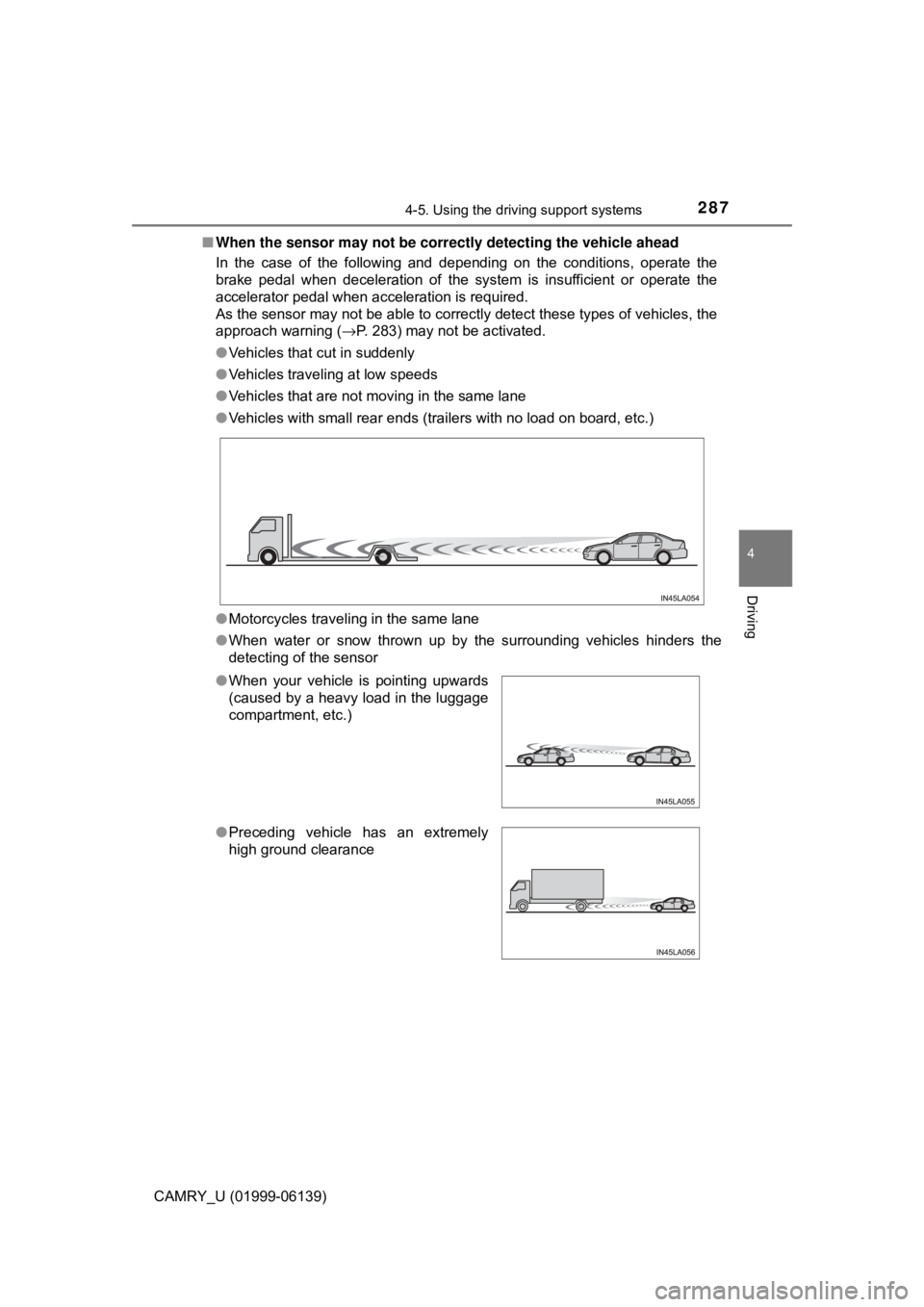
2874-5. Using the driving support systems
4
Driving
CAMRY_U (01999-06139)■
When the sensor may not be correctly detecting the vehicle ahead
In the case of the following and depending on the conditions, operate the
brake pedal when deceleration of the system is insufficient or operate the
accelerator pedal when acceleration is required.
As the sensor may not be able to correctly detect these types of vehicles, the
approach warning ( →P. 283) may not be activated.
● Vehicles that cut in suddenly
● Vehicles traveling at low speeds
● Vehicles that are not moving in the same lane
● Vehicles with small rear ends (trailers with no load on board, etc.)
● Motorcycles traveling in the same lane
● When water or snow thrown up by the surrounding vehicles hinders the
detecting of the sensor
●When your vehicle is pointing upwards
(caused by a heavy load in the luggage
compartment, etc.)
●Preceding vehicle has an extremely
high ground clearance
Page 608 of 612

608Alphabetical index
CAMRY_U (01999-06139)
Seat heater switches ............ 369
“SOS” button ......................... 402
Talk switch
*
Trunk opener switch ............. 144
Vehicle-to-vehicle distance button ........... 263, 276
VSC OFF switch ................... 295
Window lock switch............... 170
Windshield wiper and washer switch ..................... 227
Tachometer ................................ 84
Tail lights Light switch ........................... 219
Replacing light bulbs............. 483
Talk switch
*
Theft deterrent system
Alarm ...................................... 74
Engine immobilizer system ..... 71
Tire inflation pressure ............. 459 Maintenance data ................. 547
Warning light ......................... 500
Tire information ....................... 554 Glossary................................ 561
Size ....................................... 557
Tire identification number ..... 556
Uniform Tire Quality Grading............................... 559 Tire pressure
warning system
Initializing .............................. 446
Installing tire pressure
warning valve and
transmitters ........................ 446
Registering ID codes ............ 448
Warning light......................... 500
Tires .......................................... 444
Chains .................................. 346
Checking............................... 444
Glossary ............................... 561
If you have a flat tire ............. 512
Inflation pressure .................. 547
Replacing.............................. 512
Rotating tires ........................ 444
Size....................................... 547
Snow tires ............................. 347
Spare tire .............................. 512
Tire pressure warning system .......... ...................... 445
Uniform Tire Quality Grading .............................. 559
Warning light......................... 500
Tools ......................................... 513
Top tether strap ......................... 68
Total load capacity .................. 195
Towing Dinghy towing ....................... 197
Emergency towing ................ 489
Towing eyelet ....................... 491
Trailer towing ........................ 196
Toyota Entune
*
T